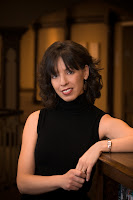Trumpeter, professor of music, and director of the Little Big Band jazz ensemble, Mike Davison, previews Salsa Mania -- a night of music and dance beginning on March 30, 2013 at Richmond CenterStage. Salsa Mania will include a lecture at 6pm, dance lessons at 6:30pm, and a performance by Chris Washburn and S.Y.O.T.O.S. with special guests the UR Jazz Ensemble at 7:30pm. Tickets are available here.
University of Richmond Jazz Ensemble
&
S.Y.O.T.O.S., With Chris Washburne, trombone
I remember the first time I heard
the word salsa. It was the 70s, and I was asked to play
a gig in New York. Since salsa was Spanish for “sauce,” I thought
that the gig would include a meal!
Little did I know that salsa
is a music and dance style that began in New York City. The music is a result of the blending of
American jazz with a few styles of Cuban music including son, son montuno, guaracha, cha cha cha, mambo, and bolero. New
York City Latin music promoter Izzy Sanabria claims to have used the salsa label first in his English publication,
Latin New York magazine, in 1973.
In spite of salsa’s sketchy etymological history, the music is a lot
like the food – it is muy caliente
(very hot!). Instead of mixing
tomatoes, onions, and hot peppers, you take Cuban rhythms, sprinkle in elements
of American jazz – improvisation, harmony, horn voicings, and phrasing – mix it
together and presto chango, you get salsa – the music! American jazz blended
with the Cuban music called son in
the 20s. Son is considered the perfect blend of the Spanish guitar and the
African drum, and was mixed (here goes the food metaphor, again!) and received
its sabor in Cuba. Son
has been ‘updated’ or repackaged through the years, and turned into new
styles of dance music in the United States and the world: Mambo
and Latin jazz in the 50s, Salsa in the
60s, and Timba in the 70s.
As Gloria Estefan sings, “The
Rhythm is Gonna Get You”… Salsa Mania is designed to get you on your feet! Saturday's
concert will feature the University of Richmond Jazz Ensemble, led by Dr. Mike
Davison, and New York’s hottest salsa group See You On The Other Side (S.Y.O.T.O.S) led by
trombonist and Columbia University professor, Chris Washburne.
While completing my doctorate at
the University of Wisconsin – Madison, I performed in the top jazz
ensemble. Chris, who was an undergraduate
at that time, also performed in the group. After getting to know Chris’s outstanding playing, we did
not see each other for years, until we both realized that we shared a similar
interest: Salsa! Chris now leads
the Louis Armstrong school of Jazz and the ethnomusicology area at Columbia
University in New York City. Since
our reacquaintance, Chris has been our guest artist at the University of
Richmond and also appears in my documentary Cuba:
Rhythm in Motion. Chris has
performed with Tito Puente, Eddie
Palmieri, Celia Cruz, Ray Barretto, Mark Anthony, Justin Timberlake, Celine
Dion, Gloria Estefan, and the Duke Ellington Orchestra. We are very excited to have Chris and
his group perform on the Modlin Arts Series. Their blend of salsa is
exciting, danceable, and fun!
The March 30th Salsa Mania event will include a lecture - a discussion by Chris and yours truly
about salsa; a salsa dance class taught by
Edwin Roa, and the concert. The
music is specifically designed to make you get up and dance.
In America, we say that when a baby
finally stands up, she is walking.
In Cuba, they say that she is dancing! We hope you will join us for Salsa Mania! You might not eat, but you will certainly
dance!
_____________________________________________________________________________________

Distinguished trumpeter Dr. Michael Davison is a University of Richmond Music Professor and Director of Jazz Ensmble. Davison is a legendary performer,
respected professor, published composer, and ethnomusicologist.
Davison’s love of music has shaped his life and career. He is in demand
across the country as a classical and jazz performer and educator. As a
performer, he has given jazz and classical recitals all over the United
States as well as in parts of France, the Netherlands, Spain, South
Africa, China and Cuba. Davison has recorded four jazz CDs as both a
leader and sideman. His classical CD, Fenster, received rave reviews
from the International Trumpet Guild Journal. Widely considered an
expert in Cuban music, he performs and teaches Cuban music at the
University of Richmond and worldwide. As a jazz musician, Davison has
performed with the late tenor saxophonist and 11-time Grammy winner,
Michael Brecker, popular jazz trombonist, Curtis Fuller and legendary
Latin jazz saxophonist and composer, Justo Almario. He has also
performed alongside some of Motown’s most iconic singers and groups,
including Natalie Cole, Aretha Franklin, the Temptations and The Four
Tops. As a classical musician, Davison has performed with Rhythm and
Brass, a group that plays everything from Bach to Pink Floyd. He has
performed with the Wisconsin and Whitewater Brass Quintets, the
Rochester Philharmonic, Wisconsin Symphony, Wisconsin Chamber Orchestra,
and the Richmond Symphony. Davison has performed for Pope John II and
George Leonard Carey, Archbishop of Canterbury.
His influence as an educator goes beyond the University of Richmond
campus. Davison also serves as trumpet instructor and head of the brass
area at the world-renowned Interlochen International Arts Camp in
Interlochen, Michigan. He hosted the International Trumpet Guild
Conference in 1999 and is an Edwards Instrument Performing Artist.
Davison, along with producer Ed Tillett, completed Cuba: Rhythm in
Motion, a documentary tracing the musical genealogy between Cuban
rhythms and American jazz. The film premiered on the campus of the
University of Richmond in 2007 and has been shown around the world,
including Spain, Australia and Mexico. Dr. Davison is presently writing a
book on Cuban folk music.



